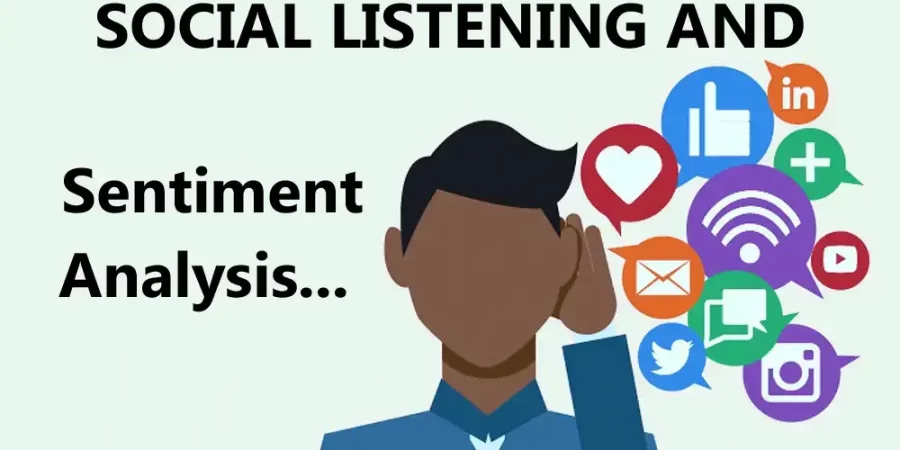Beginners Guide: How To Use Social Listening And Sentiment Analysis To Understand Customer Opinions?
Social listening and sentiment analysis are powerful tools that businesses can use to understand customer opinions and make data-driven decisions.
Social listening is the process of monitoring social media platforms for mentions of a brand, product, or industry. This can include tracking mentions of a brand on platforms like Twitter, Facebook, Instagram, and LinkedIn, as well as monitoring forums, blogs, and other online communities. By collecting data on what customers are saying about a brand or product, businesses can gain insight into customer opinions and preferences.
Sentiment analysis, on the other hand, is the process of using natural language processing and machine learning techniques to automatically identify and extract subjective information from text. This can include determining the overall sentiment of a piece of text (positive, negative, neutral) as well as identifying specific emotions and opinions.
When used together, social listening and sentiment analysis can provide a comprehensive view of customer opinions. Businesses can use this information to identify patterns and trends in customer feedback, track the effectiveness of marketing campaigns, and make data-driven decisions.
To get started with social listening and sentiment analysis, businesses can use a variety of tools, such as Hootsuite Insights, Brand24, and Mention. These tools allow businesses to monitor multiple social media platforms and identify mentions of their brand or product. Some tools also include sentiment analysis capabilities, allowing businesses to automatically classify the sentiment of mentions.
Once businesses have collected data on customer opinions, they can use this information to identify patterns and trends. For example, if customers are consistently mentioning a specific feature or problem with a product, businesses can use this information to improve the product or address customer concerns.
In addition, businesses can use social listening and sentiment analysis to track the effectiveness of marketing campaigns. By monitoring mentions of a campaign on social media, businesses can see how customers are reacting and make adjustments as needed.
Another use case for social listening and sentiment analysis is for customer service. By monitoring social media, businesses can identify customer complaints or issues and respond promptly. This can help to improve customer satisfaction and reduce negative sentiment.
Social listening and sentiment analysis are powerful tools that businesses can use to understand customer opinions and make data-driven decisions. By monitoring social media and extracting sentiment from customer feedback, businesses can identify patterns and trends, track the effectiveness of marketing campaigns, and improve customer service. It is important to keep in mind that these tools and analysis should be used in conjunction with other data sources to ensure a holistic view of customer opinions and feedback.
Another important aspect of social listening and sentiment analysis is identifying influencers and brand advocates. Influencers are individuals who have a significant following on social media and can have a significant impact on a brand’s reputation. By identifying these influencers, businesses can reach out to them and potentially collaborate on campaigns or promotions.
On the other hand, brand advocates are customers who consistently speak positively about a brand or product. By identifying these individuals, businesses can leverage their positive sentiment to improve their reputation and attract new customers.
Another key aspect of social listening and sentiment analysis is understanding the competition. By monitoring mentions of competitors on social media, businesses can gain insight into what customers like and dislike about their products and services. This can help businesses to differentiate themselves and improve their own offerings.
One important thing to keep in mind when using social listening and sentiment analysis is the importance of data privacy and security. Businesses must ensure that they are compliant with data privacy laws and regulations, such as the General Data Protection Regulation (GDPR) and the California Consumer Privacy Act (CCPA). This may include obtaining consent from customers before collecting and analyzing their data, as well as implementing appropriate security measures to protect data.
In addition to data privacy and security, it is important to consider ethical and fair use of data. Businesses must ensure that they are not using data in a way that is discriminatory or harms customers.
Businesses should be aware that social listening and sentiment analysis are not a one-time effort, but rather an ongoing process. Businesses should regularly monitor social media and customer feedback to stay up-to-date on customer opinions and preferences. This will allow businesses to make data-driven decisions and continuously improve their products and services.
Here are some key takeaways from the article on “How to use social listening and sentiment analysis to understand customer opinions”:
- Social listening is the process of monitoring social media platforms for mentions of a brand, product, or industry. This can include tracking mentions of a brand on platforms like Twitter, Facebook, Instagram, and LinkedIn, as well as monitoring forums, blogs, and other online communities.
- Sentiment analysis is the process of using natural language processing and machine learning techniques to automatically identify and extract subjective information from text. This can include determining the overall sentiment of a piece of text (positive, negative, neutral) as well as identifying specific emotions and opinions.
- When used together, social listening and sentiment analysis can provide a comprehensive view of customer opinions. Businesses can use this information to identify patterns and trends in customer feedback, track the effectiveness of marketing campaigns, and make data-driven decisions.
- To get started with social listening and sentiment analysis, businesses can use a variety of tools such as Hootsuite Insights, Brand24, and Mention. These tools allow businesses to monitor multiple social media platforms and identify mentions of their brand or product.
- Another important aspect of social listening and sentiment analysis is identifying influencers and brand advocates. Influencers are individuals who have a significant following on social media and can have a significant impact on a brand’s reputation. By identifying these influencers, businesses can reach out to them and potentially collaborate on campaigns or promotions.
- Another key aspect of social listening and sentiment analysis is understanding the competition. By monitoring mentions of competitors on social media, businesses can gain insight into what customers like and dislike about their products and services.
- Businesses must ensure that they are compliant with data privacy laws and regulations, such as the General Data Protection Regulation (GDPR) and the California Consumer Privacy Act (CCPA). This may include obtaining consent from customers before collecting and analyzing their data, as well as implementing appropriate security measures to protect data.
- Businesses must ensure that they are not using data in a way that is discriminatory or harms customers.
- Social listening and sentiment analysis are not a one-time effort, but rather an ongoing process. Businesses should regularly monitor social media and customer feedback to stay up-to-date on customer opinions and preferences.
- One key benefit of using social listening and sentiment analysis is the ability to identify patterns and trends in customer feedback. This can help businesses to understand customer opinions and preferences, and make data-driven decisions.
- By using sentiment analysis, businesses can determine the overall sentiment of customer feedback, which can help to identify areas of improvement or areas where the company is excelling.
- Social listening and sentiment analysis can also be used to track the effectiveness of marketing campaigns. By monitoring mentions of a campaign on social media, businesses can see how customers are reacting and make adjustments as needed.
- Another use case for social listening and sentiment analysis is for customer service. By monitoring social media, businesses can identify customer complaints or issues and respond promptly. This can help to improve customer satisfaction and reduce negative sentiment.
- Identifying influencers and brand advocates can be a powerful tool for businesses. By reaching out to these individuals, businesses can leverage their positive sentiment to improve their reputation and attract new customers.
- Understanding the competition is also important, this can help businesses to differentiate themselves and improve their own offerings.
- It’s important to consider ethical and fair use of data while using social listening and sentiment analysis. Businesses should ensure that they are not using data in a way that is discriminatory or harms customers.
- Regularly monitoring social media and customer feedback is crucial to stay up-to-date on customer opinions and preferences. This will allow businesses to make data-driven decisions and continuously improve their products and services.
- To gain a holistic view of customer opinions, businesses should use social listening and sentiment analysis in conjunction with other data sources like surveys, customer complaints, and customer support logs.
- Businesses should also be aware that social listening and sentiment analysis should be used in conjunction with other data sources like surveys, customer complaints, and customer support logs. This will help to ensure that businesses are getting a comprehensive view of customer opinions and feedback.
In conclusion, social listening and sentiment analysis are powerful tools that businesses can use to understand customer opinions and make data-driven decisions. By monitoring social media and extracting sentiment from customer feedback, businesses can identify patterns and trends, track the effectiveness of marketing campaigns, and improve customer service.
Additionally, it can help identify influencers and brand advocates, understand the competition, keep in mind the importance of data privacy and security and ethical considerations. Regularly monitoring social media and customer feedback is crucial to stay up-to-date on customer opinions and preferences. and gain a holistic view of customer opinions, businesses should use social listening and sentiment analysis in conjunction with other data sources.





Leave a Reply